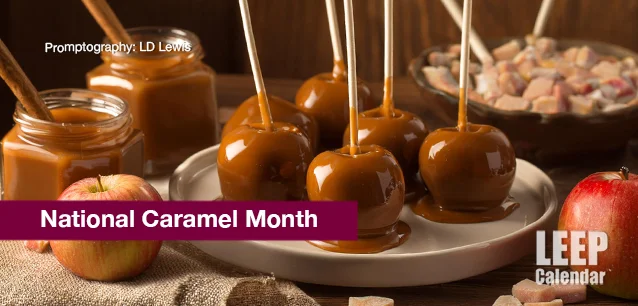 AD
AD
Today is: November 28
Scroll to explore events active on this date.
Additional Events on LEEP
LEEP INK FEATURES

2025 is the Year of...
21 Themes and 'Year of' Events for 2025 PART ONE, THE FIRST 12 Every year, various organizations announce the theme for the year. These themes can focus on causes, such as aesthetics and color tre...

Nuanced November 2024
November is the start of the holiday season in many parts of the world. It is a time for family, football, food, shopping and decorating, particularly in the Christian and Jewish world, leading to Christmas and...

December's Gift
Events in December 2024. Well, we made it to December. December is the holiday season, particularly in Western nations, where Christianity and Judaism are the faiths most common in the nation's past. ...
About National Caramel Month
Ends: Oct 31, 2025
DESCRIPTION:
NATIONAL CARAMEL MONTH:
AN OVERVIEW AND HISTORY
National Caramel Month is dedicated to the sweet, rich, and versatile confection known as caramel. This month-long celebration highlights caramel's cultural and culinary significance, encouraging people to explore and enjoy the variety of foods and treats made with caramel. It also serves as an opportunity for confectioners and food producers to showcase their caramel-based products. It is an unofficial event without a sponsor.
WHERE CARAMEL COMES FROM
The history of caramel dates back to at least the 17th century. The word "caramel" is believed to be derived from the Spanish "caramelo," which may have originated from the Latin word "cannamellis," meaning "sugar cane." Caramel was likely accidentally discovered when sugar was cooked over a fire and melted, forming a brown, sweet substance. Early caramel was a simple combination of sugar and water heated until the sugar melted and browned.
Over time, the caramel recipe evolved, adding milk, cream, butter, and vanilla, creating the rich, creamy caramel we know today. Caramel became especially popular in the 19th century, coinciding with the growth of the confectionery industry. Today, caramel is used in various desserts, candies, and savory dishes.
COMMON FOODS USING CARAMEL
Caramel is a versatile ingredient used in many popular foods and desserts. Some of the most common include:
—Caramel Apples
A classic treat, especially during the fall, when apples are dipped in warm caramel and sometimes coated with nuts, chocolate, or sprinkles.
—Caramel Sauce
Used as a topping for ice cream, cakes, and other desserts. It's also a key ingredient in creating caramel-flavored beverages, like caramel lattes or frappes.
—Caramel Candies
Soft or hard candies are made primarily from caramelized sugar, cream, butter, and vanilla.
—Caramel Popcorn
Popcorn coated in a sweet caramel glaze is often enjoyed as a snack or treat during holidays or at events like fairs.
—Caramel Flan
A custard dessert topped with a layer of soft caramel, prevalent in many cultures, particularly in Latin American cuisine.
THE IMPORTANCE OF NATIONAL CARAMEL MONTH
National Caramel Month is important for several reasons:
Celebration of Tradition: Caramel has a long history and is a beloved ingredient in many cultures. This month allows people to celebrate and preserve these culinary traditions.
—Innovation in Food
Caramel continues to be an area of innovation in the food industry, with new caramel-based products and recipes being introduced. National Caramel Month helps promote these innovations and encourages people to try new caramel creations.
—Economic Impact
For confectioners, bakeries, and food producers, National Caramel Month is an opportunity to boost sales and market their caramel products, contributing to the economy.
—Cultural Significance
Caramel plays a significant role in various cultural celebrations and traditions, particularly in the fall. This month, it is highlighted in festive foods and traditions.
National Caramel Month in October celebrates caramel's rich history and versatility. This beloved confection has found its way into a wide range of foods and desserts. The month is a time to enjoy traditional caramel treats and explore innovations in caramel-based foods.
VIDEOS
SUPPORTING DOCUMENTS
Currently, this event does not have supporting documents.
ADDITIONAL IMAGES
Currently, this event does not have supporting images.
Where would you like to go now?
 AD
AD


/footer-logo.svg)
